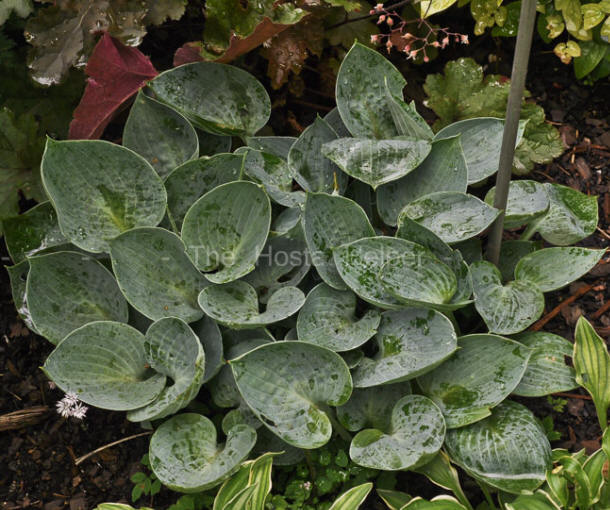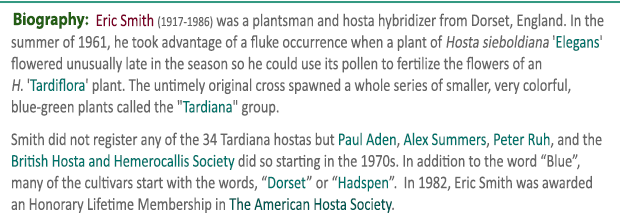|
 This
Tardiana-type (H. 'Tardiflora' ×
H. 'Elegans') blue-green hosta was
registered by Paul Aden of New York on behalf of
British hybridizer,
Eric Smith in 1977. The small size (10 inches high by 24 inches wide) mound of slug resistant foliage has a very slow growth rate and very pale lavender
flowers in August. This cultivar is part of the "Dorset
Series" of hostas. This
Tardiana-type (H. 'Tardiflora' ×
H. 'Elegans') blue-green hosta was
registered by Paul Aden of New York on behalf of
British hybridizer,
Eric Smith in 1977. The small size (10 inches high by 24 inches wide) mound of slug resistant foliage has a very slow growth rate and very pale lavender
flowers in August. This cultivar is part of the "Dorset
Series" of hostas.
The Hosta Handbook by Mark Zilis (2000) says "Herb
Benedict utilized it in developing such hostas as 'Blue
Ice' and 'Blue Chip'."
 The Hostapedia by
Mark Zilis (2009)
states that this cultivar "...ranks as one of the
smallest of Eric Smith's Tardianas...has also proven to be an
excellent breeding plant...Its only negative is an extremely
slow growth rate, but that should not stop anyone from including
it in their collection." The Hostapedia by
Mark Zilis (2009)
states that this cultivar "...ranks as one of the
smallest of Eric Smith's Tardianas...has also proven to be an
excellent breeding plant...Its only negative is an extremely
slow growth rate, but that should not stop anyone from including
it in their collection."
From the
Field Guide to Hostas by Mark Zilis (2014), "...the best small, blue-leaved cultivar, despite
being registered 36 years ago...remains a favorite
of hybridizers."
 The New Encyclopedia of Hostas by
Diana
Grenfell (2009) states: "Much used in breeding for small, blue-leaved
hostas. The attractive silver overlay on the leaves makes this
small member of the Tardiana Group a must-have for collectors of
the bluest-leaved hostas." The New Encyclopedia of Hostas by
Diana
Grenfell (2009) states: "Much used in breeding for small, blue-leaved
hostas. The attractive silver overlay on the leaves makes this
small member of the Tardiana Group a must-have for collectors of
the bluest-leaved hostas."
 Nomenclature changes
recommended in the 1991 book
The Genus Hosta by
W. George Schmid and accepted by The American Hosta Society would update names as follows: H. x
tardiana is now the Tardiana Group. Nomenclature changes
recommended in the 1991 book
The Genus Hosta by
W. George Schmid and accepted by The American Hosta Society would update names as follows: H. x
tardiana is now the Tardiana Group.

 An article by Warren I. Pollock in
The
Hosta Journal (1985 Vol. 16) states that, "In a November
11, 1976 letter, Smith stated that 'Blue Lagoon' is his provisional name for
the H. x tardiana numbered TF2x4. In 1977, however, the name
'Dorset Blue' was officially registered this hosta on behalf of Eric
Smith by
Paul Aden. .."
An article by Warren I. Pollock in
The
Hosta Journal (1993 Vol. 24 No. 1) states that
“H. ‘Dorset Blue’ (TF 2x4) is sometimes confused with ‘Blue
Moon’ and vice versa. Many CCs (cognoscenti of
connoisseurs) favor it over ‘Blue Moon’, saying it is
Smith’s best small-mounded Tardiana…’Dorset Blue’ is reported to
be faster growing, have somewhat larger leaves, have deeper blue
coloring in some gardens and hold the blue for a longer time,
such as well into August.”

The
Hosta Journal (1993 Vol. 24 No. 2) contained an article
by
Dr Bob Olson regarding a visit he and others made to the
garden of
Dr Ralph (Herb) Benedict. "We spent the afternoon looking at
the end result of his marvelous hybridization scheme. Dr.
Benedict would recite the perfect logic by which such crosses
were conceived and executed.
Tardianas to the F-6 generation were created by crossing the
most fertile of one hundred 'Dorset
Blue's with their most fertile offspring. He ended up
creating more new Tardianas than
Eric Smith had done. (Smith was thwarted at the F-3
generation when he ran into relatively sterile plants.) The
blues Dr. Benedict chose to name are all rather small and very
blue indeed. In order of decreasing size: 'Blue
Jay', 'Blue Ice', 'Blue
Chip', and the smallest of the lot 'Blue
Urchin'...Somehow in his crosses he came up with a pure
Tardiana hybrid which is streaked and splashed - and give
variegated seedlings (often fifty percent or more)...he produced
a 'Dorothy
Benedict'-like-Tardiana, 'Dorset
Clown'. The possibilities of this plant ignited our
imaginations: can you envision a whole series of variegated
Tardiana offspring?"
An article by C.H. Falstad about the stability of colors in hosta leaves in
The
Hosta Journal (2006 Vol. 37 No. 1) says, "Other plants
tend not to sport often. Take for example 'Dorset Blue'...In the tens of
thousands of plants propagated at
Walters Gardens, I have seen only one sport in
our stock."
A Photo Essay article by Steve Chamberlain in
The
Hostta Journal (2010 Vol. 41 No. 1) makes comments about
H. 'Wolverine', "Jim Wilkins registered this sport of a 'Dorset Blue' seedling
in 1995. In the spring, there is beautiful contrast between the blue center and
the creamy white margin. As the wax washes off, the center becomes a solid
green."
|
 |
 |
|
|
"I can't
believe this one isn't on the list
already. In fact, it's one I nearly
passed over, assuming it was already
listed. Not only do the small, cupped
leaves have some of the best intense
blue of any blue hostas I grow, but it
keeps the blue longer than any other.
The flower scapes only reach a maximum
of eight inches for me, putting them in
excellent proportion to the tidy,
low-growing mound. This beauty can be
obtained from nearly every hosta
mail-order source, running between
$15.00 to $20.00." |
|













 |



